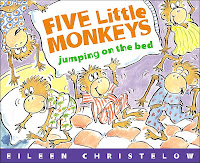FIVE Little MONKEYS jumping on the bed
By: Eileen Christelow
Five Little Monkeys jumping on the bed, to me, is a counting book as well as a pattern book. The author counts down from 5 monkeys to 1 monkey. She also uses patterns in her book to emphasize phonological features. Most children will know this story, which will help them learn to read because they may know the words already. If I was a teacher, I would sing the book, and have the children sing along with me. Since the children probably already know this song, I would have each child have each child have the book in front of them, so while they are saying the words, they see what the words look like.
Five Little Monkeys jumping on the bed is a song that most children know. It is about 5 children monkeys who are going to bed. The mom monkey puts the five children monkeys to bed, but then they start jumping on the bed. As every page goes on, another monkey falls off the bed and bumps his head. The mom monkey then has to call the doctor and the doctor says, "No more monkeys jumping on the bed!". Finally, all of the monkeys fall off the bed and get hurt. They finally all go to bed and the mom monkey then gets to go to bed. When she goes to bed, she jumps on it as well. Therefore, the children get a funny ending.
This picture book has good readability. It has a high concentration of Dolch words, or sight words. Some of these words are it, was, so, a, little, put, on, their, five, said, good, to, then, the, one, off, and, four, etc. There are Dolch words on every page of this story, and more than two on each page. The 3R's are also included in this book. There is rhyme throughout the whole book. There is rhythm throughout the book, which is why it is a song. There is also repetition; the story always says "No more monkeys jumping on the bed!" The story also has good picture to text matching. Every picture on every page shows what the monkey are doing. Therefore, if the child does not know this story, they can figure the words out by the pictures. This story also offers something to both the reader and promote interactive discussions. Readers may have a connection with this song, and possibly if they have children. Students may love to jump on the bed and a lesson can be learned in this story. Students can also sing, and read, along.
I think this book is an excellent picture book. I also think it is an excellent book. It will help children learn to read because they know the words already. Therefore, they will begin to recognize the words and understand them.

I think its a great idea to select a picture book that tells a story children are already familiar with. It will keep them engaged and participating because they know the next line and the next event that will take place.
ReplyDeleteI think your students would really enjoying having the book read to them, and ofcourse singing along and/or acting it out. To this day, I can still remember doing that very thing when I was in elementary school. Our teacher would direct us in acting out this very story, Five Little Monkeys Jumping On The Bed. If doing that so many years ago has stuck with me until this day, I think that it is a clear indicator that it is an effective way to present this book.
Five Little Monkeys Jumping On The Bed definitely seems like a good picture book choice based on your reasoning that it includes many Dolch words (and I appreciate the examples that you listed), as well as the 3Rs that you should look for in a quality children's picture book.
I think it would be a great idea to have students create their own counting story by drawing their own series of pictures using different animals jumping on the bed (each picture would have one less of their chosen animal) and in turn creating their own picture book modeled after Five Little Monkeys Jumping On The Bed.
Excellent idea! Thank you!
ReplyDelete